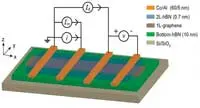 A device based on a bilayer of graphene and boron nitride which is said to show unprecedented spin transport efficiency at room temperature has been created by Graphene Flagship scientists based at the University of Groningen, The Netherlands.
A device based on a bilayer of graphene and boron nitride which is said to show unprecedented spin transport efficiency at room temperature has been created by Graphene Flagship scientists based at the University of Groningen, The Netherlands. A device based on a bilayer of graphene and boron nitride which is said to show unprecedented spin transport efficiency at room temperature has been created by Graphene Flagship scientists based at the University of Groningen, The Netherlands.
A device based on a bilayer of graphene and boron nitride which is said to show unprecedented spin transport efficiency at room temperature has been created by Graphene Flagship scientists based at the University of Groningen, The Netherlands.
According to the researchers, the spin signal is so large that it can be used in real life applications such as spin based logic gates and transistors.
The research team showed that they could greatly improve the efficiency of the injection and detection of spin electrons into graphene by using the insulator boron nitride in between the graphene layer and the ferromagnetic spin injector/detector electrodes.
“Graphene is a very good material for spin transport, but it does not allow one to manipulate the spins,” says Professor Bart van Wees. “To inject spins into the graphene, one has to make them pass from a ferromagnet through a boron nitride insulator by quantum tunnelling. We found that using a two-atom layer of boron nitride resulted in a very strong spin polarisation of up to 70% – ten times what we usually get.”
In the devices produced, the researchers claim the polarisation increased with voltage, challenging the current thinking that it is only the ferromagnetic that polarises spin. Instead it would seem that it is the quantum tunnelling that polarises the spin.
The researchers also found a similar tenfold increase in spin detection in the same device. “So overall, the signal increased by a factor of 100,” said van Wees.
“We can now inject spins into graphene and measure them easily after they travel some distance. One application would be as a detector for magnetic fields.”
Author
Peggy Lee
Source: www.newelectronics.co.uk